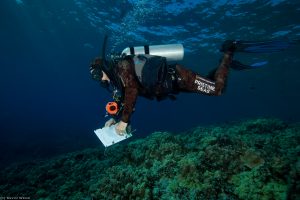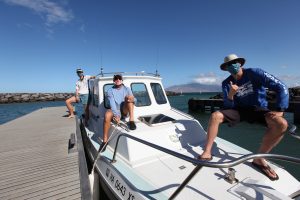Molokini During COVID-19: Free Webinar Looks at Research Conducted at the Island During Height of the Pandemic
KIHEI – With no boats around at the one of the most popular snorkeling sites in Hawaii, Molokini thrived. At least that’s what a small team of researchers discovered when they studied the island during the height of the COVID-19 pandemic.
The public is invited to learn more about this unique study in a free webinar on September 28 at 5:30 PM HT. Researchers involved in the study will share their findings which compare Molokini during the pandemic vs past and present times. This presentation is part of Maui Nui Marine Resource Councilʻs monthly Know Your Ocean Speaker Series, sponsored by the County of Maui. Registration is free but is required in advance of the webinar. Register here: https://us02web.zoom.us/webinar/register/WN_fBY0v5QCQ_eqwAMVfYAGWg
Molokini Marine Preserve is normally visited by approximately 1,000 tourists every day. During COVID-19 when tourism was switched off and there were no tour boats and no snorkelers at Molokini, researchers had a once-in-a-lifetime opportunity to understand how human activity affects how wildlife uses the reserve.
“Many animals are afraid of humans, but since people visit Molokini every day, we didn’t know how they would use the habitat if we were absent,” said Kevin Weng, Associate Professor at the Virginia Institute of Marine Science. “Covid caused a ‘natural experiment’ that dramatically reduced human presence, allowing us to see wildlife in a more pristine system.”

Photo by Kevin Weng
“Tourism at Molokini provides benefits to the local economy and gives people an appreciation for what a healthy marine ecosystem looks like,” said Alan Friedlander, Chief Scientist for the National Geographic Society’s Pristine Seas program. “What is needed is the right balance of tourism at Molokini so that both people and wildlife benefit from this exceptional place.”
The study was made possible by more than 55 donors who collectively contributed cash, lodging, airfare, boat use and vehicles for the four researchers working on the project. In all, more than $3,500 was raised through a fundraising effort led by Maui Nui Marine Resource Council, as well as the value of the in-kind contributions.
Led by Maui resident Russell Sparks, Aquatic Biologist, Department of Land and Natural Resources, Division of Aquatic Resources on Maui, a small team of scientists with expertise in coral reef ecology and animal movement studies in the Hawaiian Islands studied the ecosystem at Molokini for a little over a full year: from a period of COVID-19 pandemic shut down in April 2020, to a period of moderate activity resumption in November 2020 and into a full return of tourism in May of 2021.

Photo by Kevin Weng
The team includes Alan Friedlander, Chief Scientist, Pristine Seas, National Geographic Society, and a researcher at the Hawaiʻi Institute of Marine Biology. Friedlander has studied Molokini extensively for nearly two decades and is the co-author of five research publications on Molokini conducted in collaboration with the Maui Division of Aquatic Resources. Other members include Kevin Weng, Associate Professor at the Virginia Institute of Marine Science, Whitney Goodell, National Geographic Fellow and marine ecologist with the Fisheries Ecology Research Lab, University of Hawaiʻi, and Laura Gajdzik, scientist at the Division of Aquatic Resources.
“Maui Nui Marine Resource Council is humbled to have been involved in supporting this unique study,” said Meredith Beeson, Project and Research Coordinator at MNMRC. “We’re excited at the chance to share the eye-opening findings with the public.”
More about the researchers:
Russell Sparks is an Aquatic Biologist for the Maui District Office of the Division of Aquatic Resources (DAR). He has worked for the Maui DAR since 1998 and has helped develop the Maui Marine Monitoring program, as well as helped to move forward several important marine resource management efforts. He is the DAR Biologist in charge of managing the Molokini MLCD and has worked very closely with marine tour operators over the years to implement vessel passenger reporting, and more recently to coordinate schedules to help reduce crowding and other concerns within the MLCD.
Kevin Weng studies the spatial ecology, migration and habitat requirements of fishes and seeks to provide scientific guidance for management and conservation. Present work includes studies of reef fish life history to inform size limit regulations, the effects of human presence on fish communities in the context of tourism, and participation in the Holomua: Marine 30×30. He gathers data through rebreather diving, freediving, scuba diving, fishing and observation. He works at the Virginia Institute of Marine Science at the College of William & Mary.
Whitney Goodell is a marine ecologist and geospatial analyst with National Geographic Pristine Seas. She is based in Honolulu, Hawaii, and earned her Master of Science in the Fisheries Ecology Research Lab at the University of Hawaii at Mānoa in 2015. She uses tools such as underwater surveys and remote cameras to observe biological communities of the ocean, from shallow nearshore habitats down to the deep ocean seafloor. By evaluating biological information in a spatial context, Goodell enjoys building a better understanding of patterns and relationships that drive biological distributions in the ocean, and applying this information to improved stewardship of our marine ecosystems.
Over the past 40 years Dr. Alan Friedlander has spent 12,000 hours underwater—from coral reefs to the poles and to depths of thousands of meters. Dr. Friedlander is Chief Scientist for the National Geographic Society’s Pristine Seas program, and a researcher at the Hawai‘i Institute of Marine Biology at the University of Hawai‘i. He leads research efforts to help understand and conserve iconic, special places in the ocean and is an expert in marine ecology, fisheries, and conservation. His work on marine protected areas ranges from small locally community-managed areas to some of the largest protected areas on the planet. Over the past decade, Alan has led 35 expeditions to some of the last wild places in the ocean, which has resulted in the creation of 25 large marine protected areas encompassing 6.5 million square kilometers. Alan received his Ph.D. from the University of Hawai‘i and was a National Research Council Postdoctoral Associate. He is a Fellow of the Royal Geographical Society, Fellow of the Explorers Club, and along with the National Geographic Pristine Seas Team, was awarded the 2014 Environmental Hero Award by the Environmental Media Association and the 2016 Crystal Compass National Award from the Russian Geographical Society.
Dr. Laura Gajdzik is a marine biologist and works as a biometrician for the Division of Aquatic Resources (DAR) in Honolulu. Her scientific background is in fish ecology, specifically about coral reef fish. During her latest postdoctoral research, Laura used underwater surveys (including scuba diving and environmental DNA sampling) to assess biodiversity patterns in coral reefs of the Red Sea and she worked on how to include climate change information in the design of marine protected areas. At DAR, her role is to provide statistical support for the analysis of marine and estuarine data from the Main Hawaiian Islands to better manage our aquatic resources for the generations to come.



No Comments
Sorry, the comment form is closed at this time.